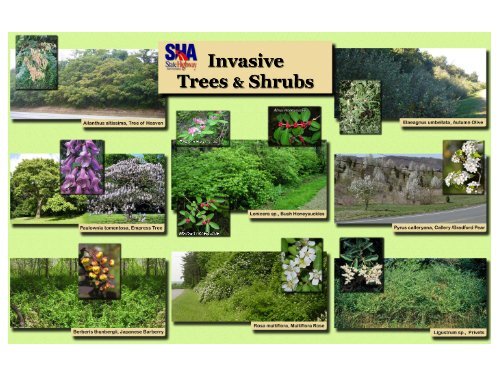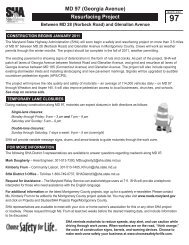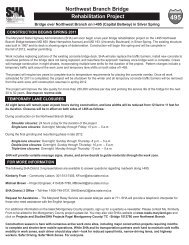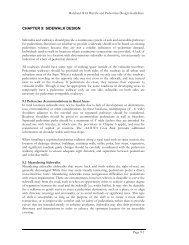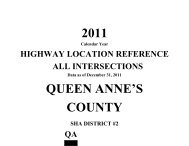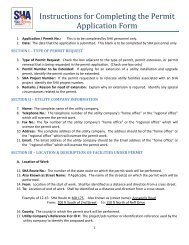Invasive Trees & Shrubs - Maryland State Highway Administration
Invasive Trees & Shrubs - Maryland State Highway Administration
Invasive Trees & Shrubs - Maryland State Highway Administration
You also want an ePaper? Increase the reach of your titles
YUMPU automatically turns print PDFs into web optimized ePapers that Google loves.
Alternate Names:<br />
Ailanthus; Shumac; Stinking<br />
sumac; Chinese sumac<br />
Height: 50 – 60 feet<br />
Origin: China and Taiwan<br />
Habitat: Full sun<br />
Distribution: 42 states<br />
through continental U.S. and<br />
Hawaii<br />
Ecological Threat:<br />
Contains chemicals which<br />
suppress the growth of native<br />
plants<br />
Reproduction: Seeds and<br />
rhizomes<br />
Dispersal: Seeds are<br />
dispersed by wind;<br />
vegetative sprouting is a<br />
result of breakage or cutting<br />
Control: Herbicide<br />
Native Alternatives:<br />
Staghorn sumac (Rhus<br />
typhina); Black walnut<br />
(Juglans nigra)<br />
Tree of Heaven<br />
Ailanthus altissima (Mill.) Swingle<br />
General: Tree of Heaven is a fast<br />
growing tree that was introduced into<br />
the U.S. in the 1740s in<br />
Pennsylvania. These trees are found<br />
in urban, suburban and rural settings.<br />
The Tree of Heaven damages<br />
structures and threatens agricultural<br />
and natural ecosystems. Tree of<br />
Heaven contains allelopathic<br />
chemicals which suppress the growth<br />
of other plants.<br />
Identification: Alternate, compound leaves are one to four feet long with up<br />
to 25 smaller leaftlets. They emit an unpleasant, skunky odor when crushed<br />
and leave shield-shaped leaf scars after the fall leaf drop. Leaflets have<br />
smooth edges with 1 or 2 teeth at the base. Seeds are green or pink in<br />
summer. They turn dry and papery in fall and may remain on the tree over<br />
winter. The Tree of Heaven is often confused with staghorn sumac which is<br />
a native tree.<br />
Tree of<br />
Heaven<br />
Staghorn<br />
Sumac<br />
Smooth leaflets with<br />
1 or 2 teeth at base<br />
Leaflets with small<br />
teeth<br />
Shield-shaped leaf<br />
scar<br />
Horseshoe-shaped<br />
leaf scar<br />
Dry, papery seed<br />
clusters<br />
Large, red seed<br />
clusters<br />
Reproduction: Tree of Heaven produces large amounts of viable seed.<br />
Vigorous resprouting can occur as a result of injury such as breakage or<br />
cutting.<br />
Control Methods: Herbicide must be used to control Tree of Heaven as<br />
cutting/felling by itself will cause the tree to produce shoots from the stump<br />
and rhizomes.<br />
References: USDA Plants Database (https://plants.usda.gov); <strong>Maryland</strong> <strong>Invasive</strong> Species Council<br />
(http://www.mdinvasivesp.org); Swearingen, J., B. Slattery, K. Reshetiloff, and S. Zwicker.2010. Plant Invaders of<br />
Mid-Atlantic Natural Areas, 4 th ed. National Park Service and U.S. Fish and Wildlife Service. Washington, DC.<br />
168pp
Alternate Names: Bradford<br />
pear<br />
Height: 30 – 50 feet<br />
Origin: China and Vietnam<br />
Habitat: Full to partial sun<br />
Distribution: Eastern U.S.<br />
from New Jersey to Illinois<br />
and south to Texas<br />
Ecological Threat: Crowds<br />
out native species that can’t<br />
tolerate deep shade or<br />
compete for space<br />
Reproduction: Fruits/seeds<br />
and root sprouts<br />
Dispersal: Seeds are spread<br />
by birds and other small<br />
mammals<br />
Control: Herbicide and<br />
mechanical removal<br />
Native Alternatives:<br />
Common serviceberry<br />
(Amelanchier arborea var.<br />
arborea); Allegheny<br />
serviceberry (Amelanchier<br />
laevis); Washington<br />
hawthorn (Crataegus<br />
laevigata)<br />
Callery Pear<br />
Pyrus calleryana Decne.<br />
General: Callery Pear was<br />
introduced into the U.S. in the early<br />
1900s for research and as rootstock<br />
for common pear trees. It gained<br />
popularity as an ornamental tree in<br />
the late 1950s. Several sterile (does<br />
not self-pollinate) cultivars were<br />
developed. The introduction of<br />
additional Callery Pear varieties<br />
allowed for cross pollination and the<br />
production of viable seed.<br />
Identification: Callery Pear reaches 30 to 50 feet high at maturity. Small<br />
white flowers bloom in early spring and often appear before the leaves are<br />
out. Leaves are 1 ½ to three inches long, shiny, dark-green and leathery with<br />
small round-toothed margins. The leaves turn deep red or purple in the fall.<br />
Small fruits mature in the fall and are hard, brown, and almost woody.<br />
Callery pears have an upright growth habit with tight branching angles,<br />
making them susceptible to breaking and splitting.<br />
Dark-green, leathery leaves with small<br />
round-tooted margins<br />
Small, hard, and brown fruits<br />
Reproduction: Callery Pears produce large amounts of seed which is spread<br />
by birds and small mammals. Callery pears also develop root sprouts which<br />
produce new trees.<br />
Control Methods: Do not plant Callery Pear or other cultivars. Seedlings<br />
can be pulled when the soil is moist. Large trees should be cut down and the<br />
stumps immediately treated with herbicide.<br />
References: USDA Plants Database (https://plants.usda.gov); <strong>Maryland</strong> <strong>Invasive</strong> Species Council<br />
(http://www.mdinvasivesp.org); Swearingen, J., B. Slattery, K. Reshetiloff, and S. Zwicker.2010. Plant Invaders of<br />
Mid-Atlantic Natural Areas, 4 th ed. National Park Service and U.S. Fish and Wildlife Service. Washington, DC.<br />
168pp
Alternate Names: Rambler<br />
rose; multiflowered rose;<br />
baby rose; Japanese rose;<br />
seven-sisters rose<br />
Height: 10 – 15 feet<br />
Origin: Japan, Korea, and<br />
Eastern China<br />
Habitat: Thrives in variety<br />
of habitats including fields,<br />
pastures, forests, prairies,<br />
and roadsides.<br />
Distribution: Throughout<br />
the eastern half of the United<br />
<strong>State</strong>s and in Washington<br />
and Oregon<br />
Ecological Threat: Forms<br />
dense thickets which<br />
displace and prevent native<br />
vegetation from establishing;<br />
disrupts nesting of native<br />
birds<br />
Reproduction: Seed and<br />
vegetatively<br />
Dispersal: Seed is dispersed<br />
by birds; tips of arching<br />
canes can form new roots<br />
and plants where they<br />
contact the ground<br />
Control: Herbicide; manual<br />
and/or mechanical removal<br />
Native Alternatives: Red<br />
chokeberry (Photinia<br />
pyrifolia); False indigo bush<br />
(Amorpha fruticosa);<br />
Common buttonbush<br />
(Cephalanthus occidentalis);<br />
Mountain laurel (Kalmia<br />
latifolia)<br />
barriers or screens for headlight glare.<br />
Multiflora Rose<br />
Rosa multiflora Thunb.<br />
General: Multiflora Rose is a multistemmed<br />
shrub or sometimes<br />
climbing vine. It was introduced to<br />
the eastern U.S. in the 1860s as<br />
rootstock for ornamental roses. In<br />
the 1930s, the U.S. Soil Conservation<br />
Service promoted its use for erosion<br />
control and as a ‘living fence’ to<br />
confine livestock. More recently,<br />
multiflora rose had been widely used<br />
in highway medians to act as crash<br />
Identification: Leaves are divided into five to 11 sharply toothed leaflets.<br />
Leaf stalks have fringed stipules (paired wing-like structures). Clusters of<br />
showy, fragrant, white to pinkish flowers bloom in May.<br />
Sharply toothed leaflets<br />
Fragrant, white flowers<br />
Reproduction: Multiflora Rose reproduces by seed as well as by forming<br />
new plants where the tips of arching canes touch the ground and form roots.<br />
Each plant produces an estimated 1 million seeds per year which remain<br />
viable in the soil for up to 20 years.<br />
Control Methods: Control of Multiflora Rose is possible using herbicide<br />
and manual or mechanical removal. Best results will be achieved from a<br />
combination of methods however. Frequent, repeated cutting or mowing can<br />
be very effective. Applying herbicide to freshly cut stems, regrowth, or<br />
foliage is effective, particularly if done solate in the growing season.<br />
References: USDA Plants Database (https://plants.usda.gov); <strong>Maryland</strong> <strong>Invasive</strong> Species Council<br />
(http://www.mdinvasivesp.org); Swearingen, J., B. Slattery, K. Reshetiloff, and S. Zwicker.2010. Plant Invaders of<br />
Mid-Atlantic Natural Areas, 4 th ed. National Park Service and U.S. Fish and Wildlife Service. Washington, DC.<br />
168pp


